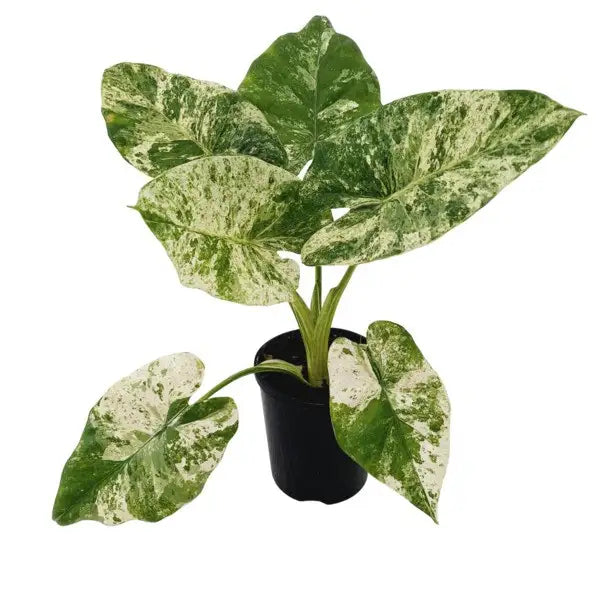
Alocasia Odora Batik Variegated - Rare
Size: Single Plant | Pot Included | Free Shipping
The Alocasia odora Batik Variegated is a stunning and sought-after Alocasia cultivar known for its large, heart-shaped leaves with unique patterns of dark green, light green, and creamy white, resembling traditional batik fabric. Like most Alocasias, it thrives in a warm, humid environment with consistent care.
Here's a comprehensive guide to Alocasia Odora Batik Variegated - Rare's care:
1. Light:
Bright, Indirect Light is Key: This Alocasia thrives in bright, indirect light. Think a spot near a north or east-facing window, or a few feet away from a south or west-facing window where it won't receive harsh direct sun.
Avoid Direct Sunlight: Direct sunlight can scorch the delicate variegated leaves, leading to irreversible damage.
Artificial Grow Lights: If natural light is insufficient, consider using artificial grow lights to provide the necessary intensity, especially to maintain vibrant variegation.
2. Watering:
Consistently Moist, Not Waterlogged: The soil should be kept consistently moist but never soggy. Alocasias are prone to root rot if they sit in standing water.
Check Soil Moisture: Water when the top 1-2 inches of soil feel dry to the touch. You can use your finger to check the moisture level.
Proper Drainage: Ensure the pot has drainage holes, and discard any excess water that collects in the saucer after watering.
Reduce Watering in Winter: During colder months or periods of dormancy, reduce watering as the plant's growth slows down.
3. Humidity:
High Humidity Lover: Being a tropical plant, Alocasia odora 'Batik Variegated' absolutely thrives in high humidity. Aim for 60-80% humidity.
Increase Humidity Methods:
Humidifier: The most effective way to provide consistent humidity is with a humidifier.
Pebble Tray: Place the pot on a tray filled with pebbles and water, ensuring the bottom of the pot isn't submerged.
Misting: While misting can provide temporary relief, it's not as effective as a humidifier for long-term humidity.
Grouping Plants: Grouping plants together can create a mini-climate with increased local humidity.
Bathroom or Kitchen: A bathroom or kitchen can be a good spot due to naturally higher humidity levels.
4. Temperature:
Warm Temperatures: This plant prefers warm temperatures between 18-27°C (65-80°F).
Avoid Cold Drafts: Protect it from cold drafts, air conditioning vents, and temperatures below 13°C (55°F), as this can cause it to go dormant or suffer damage.
5. Soil Mix:
Well-Draining and Aerated: A well-draining, rich potting mix that retains some moisture but doesn't become waterlogged is crucial.
Recommended Mix Components: A good mix can include:
Peat moss or coco coir: For moisture retention.
Perlite or pumice: For drainage and aeration.
Orchid bark: Improves drainage and aeration, mimicking its natural epiphytic tendencies.
Organic matter (e.g., compost, worm castings): Provides nutrients.
Activated horticultural charcoal: Creates more air pockets and helps filter impurities.
6. Fertilizer:
Regular Feeding During Growing Season: During the active growing season (spring and summer), fertilize regularly with a balanced liquid houseplant fertilizer.
Follow Product Instructions: Always dilute the fertilizer according to the product instructions to avoid over-fertilization, which can burn the roots.
Reduce or Stop in Winter: Reduce or stop fertilizing during the dormant period in fall and winter.
7. Potting:
Appropriate Pot Size: Choose a pot that allows for some growth but isn't too large, which can lead to excess moisture and root rot.
Good Drainage Holes: Essential for preventing waterlogging.
8. Propagation:
Division of Rhizomes/Corms: Alocasia odora 'Batik Variegated' is typically propagated through the division of its rhizomes or corms (bulb-like structures) during repotting.
How to Propagate:
Carefully remove the plant from its pot.
Gently separate the offsets or corms from the mother plant, ensuring each section has some roots.
Plant the separated sections in fresh, well-draining potting mix.
Provide warmth and high humidity to encourage rooting.
Leaf Cuttings are Not Effective: Propagation from leaf cuttings is generally not successful for Alocasias.
9. Pests and Diseases:
Common Pests: Keep an eye out for common houseplant pests like spider mites, mealybugs, aphids, and scale insects.
Treatment: If you spot pests, treat them promptly with insecticidal soap, neem oil, or other appropriate treatments.
Common Diseases:
Root Rot: Caused by overwatering or poorly draining soil. Symptoms include wilting, yellowing leaves, and mushy roots.
Leaf Spot: Fungal or bacterial diseases causing dark spots on leaves.
Prevention: Good air circulation, proper watering, and avoiding wetting the foliage during watering can help prevent diseases.
Regular Inspection: Regularly inspect your plant for any signs of pests or diseases.
10. Dormancy:
Potential for Dormancy: Alocasias can sometimes go dormant, especially in colder temperatures or with insufficient light and humidity during winter. The leaves may yellow and die back.
Don't Despair: If it goes dormant, reduce watering significantly and keep it in a warm, humid place. It often re-emerges in spring with new growth.
By providing these ideal conditions, your Alocasia odora 'Batik Variegated' will thrive and showcase its stunning, unique foliage.

